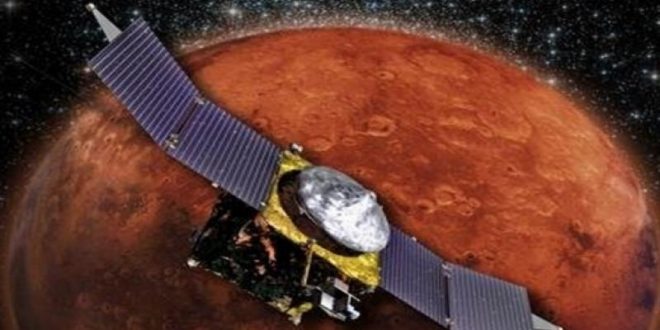NASA’s MAVEN spacecraft in orbit around Mars maneuvered out of the path of Phobos earlier this week after navigators predicted the spacecraft could run into the Martian moon in the near future, highlighting the challenge of tracking an international fleet of Mars probes set to double in size by 2021.
The Mars Atmosphere and VolatileEvolutioN (MAVEN)spacecraft has been orbiting Mars for just over two years, studying the Red Planet’s upper atmosphere, ionosphere and interactions with the sun and solar wind. On Tuesday the spacecraft carried out a rocket motor burn that boosted its velocity by 0.4 meters per second (less than 1 mile per hour). Although a small correction, it was enough that — projected to one week later when the collision would otherwise have occurred — MAVEN would miss the lumpy, crater-filled moon by about 2.5 minutes.
This is the first collision avoidance maneuver that the MAVEN spacecraft has performed at Mars to steer clear of Phobos. The orbits of both MAVEN and Phobos are known well enough that this timing difference ensures that they will not collide.
MAVEN, with an elliptical orbit around Mars, has an orbit that crosses those of other spacecraft and the moon Phobos many times over the course of a year. When the orbits cross, the objects have the possibility of colliding if they arrive at that intersection at the same time. These scenarios are known well in advance and are carefully monitored by NASA’s Jet Propulsion Laboratory (JPL) in Pasadena, California, which sounded the alert regarding the possibility of a collision.
With one week’s advance notice, it looked like MAVEN and Phobos had a good chance of hitting each other on Monday, March 6, arriving at their orbit crossing point within about 7 seconds of each other. Given Phobos’ size (modeled for simplicity as a 30-kilometer sphere, a bit larger than the actual moon in order to be conservative), they had a high probability of colliding if no action were taken.
Said MAVEN Principal Investigator Bruce Jakosky of the University of Colorado in Boulder, “Kudos to the JPL navigation and tracking teams for watching out for possible collisions every day of the year, and to the MAVEN spacecraft team for carrying out the maneuver flawlessly.”
MAVEN’s principal investigator is based at the University of Colorado’s Laboratory for Atmospheric and Space Physics, Boulder. The university provided two science instruments and leads science operations, as well as education and public outreach, for the mission. NASA’s Goddard Space Flight Center in Greenbelt, Maryland, manages the MAVEN project and provided two science instruments for the mission. Lockheed Martin built the spacecraft and is responsible for mission operations. The University of California at Berkeley’s Space Sciences Laboratory also provided four science instruments for the mission. NASA’s Jet Propulsion Laboratory in Pasadena, California, provides navigation and Deep Space Network support, as well as the Electra telecommunications relay hardware and operations.
Agencies/Canadajournal
 Canada Journal – News of the World Articles and videos to bring you the biggest Canadian news stories from across the country every day
Canada Journal – News of the World Articles and videos to bring you the biggest Canadian news stories from across the country every day



